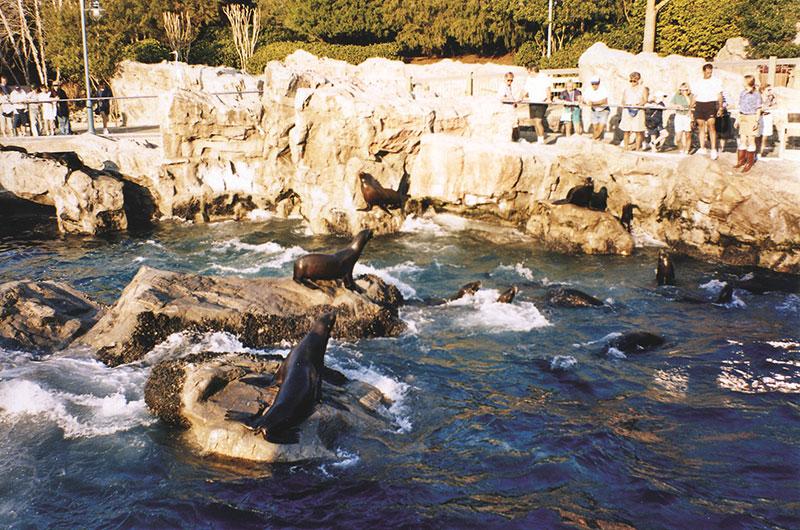Make Waves

Whether it's the surging swells of a water park wave pool, the twists and turns of an amusement park flume ride, or the relaxing meanderings of a lazy river, guests are accustomed to waves and water motion at countless attractions around the world. But at aquariums and zoos, the value of water action goes far beyond providing guest entertainment. It allows for realistic habitats that are not only visually pleasing to visitors, but also enriching to the animals living in them.
“It’s critical that when we design an animal habitat, we integrate as much unpredictability and enrichment as possible,” says Bryan Schuetze, principal and creative director for Space Haus architectural firm, who was previously senior vice president of planning and design for the Shedd Aquarium in Chicago. “Animals that are used to living in tidal zones are designed to handle significant wave action. When including wave action, not only does the habitat appear more natural, but the animals that live there feel comfortable and can thrive.”
Aquatic Development Group (ADG) in Cohoes, New York, is one of the companies specializing in this work for aquariums and zoos. Since the early 1990s, ADG has provided wave and water motion technologies for the enhancement of animal habitats. Some of its installations include the Shedd Aquarium, Georgia Aquarium, and, more recently, the sea lion exhibit at the Columbus Zoo and Aquarium, as well as the penguin exhibit at Ripley’s Aquarium of Myrtle Beach.

Seafaring animals and other shore-dwelling wildlife need the correct wave action or water motion to simulate their natural habitats. The same wave generation technology that ADG uses to power wave pools and rivers in theme and water parks is modified for zoos and aquariums to create realistic sea life exhibits.
“It’s interesting. It is an industry developed out of aquariums and zoos wanting to do more with exhibit design and for realism for the animals, and we jumped right into the challenge,” says Lewis (Lew) Wemple, business development manager for the ADG Waves product line. “Coming from an engineering and creative background, this was really intriguing to me.”
Wemple notes that a lot of knowledge of how water quality is affected by wave action and water motion comes from water park wave pools, where water is removed from the pool bottom and also through surface skimming. Aquariums and zoos also do this. “But beyond that, waves and water movement stir up the water and allow water that might otherwise be stagnant to reach the water intakes,” he says. “It’s probably most essential when we’re looking to move water over live coral. Living coral needs water movement for life support and will die if you don’t move the water to bring them food and get rid of waste.”
How It’s Done
The first step involves finding out exactly what the aquarium or zoo wants—what type of wave and how large—and that indicates the type of system needed.
“To make everyone happy at an aquarium or zoo is a process,” Wemple explains. “In the early years, we sent them VHS tapes and DVDs, and then they hopped on a plane and came here (to Cohoes). To make things more efficient and yield better results, we developed our modeling and testing phase.”
This involves ADG wave generation experts building and testing scale models of exhibits. The hands-on approach defines the specific equipment requirements and ensures that the desired wave and/or water motion effects can actually be created. It also provides something tangible for the aquarium or zoo to see.
“When considering new aquariums that simulate habitats with ocean swell, the shape of the aquarium and the type of swell-generating device is critical,” says Nate Jaros, curator of fish and invertebrates at the Aquarium of the Pacific in Long Beach, California. “It’s always best to make a scaled-down version of the habitat and work with engineers to ensure the wave will find a suitable period and reach the desired wavelength. Many specimens are not just highly adapted to live in areas of high current or swell, they actually rely on this water motion to thrive.”
Once the system is installed and activated, on-site training is conducted for the aquarium’s or zoo’s maintenance crew and engineers. The facility’s animal husbandry staff members are actively involved in the process, and they take a keen interest in the system because they’re responsible for the health, enrichment, and well-being of the animals.
“Our aquarists and curators have observed higher growth rates and more natural growth patterns among animals in systems with ideal water movement,” Jaros says.
For guests, the waves and water-motion systems create realism, and they get to see shore-dwelling animals moving up and down the beach with the water motion.
“It brings animals like penguins out that often hide, and that’s also great for the guests,” Wemple says. “When water is still, all you see animal waste and pin feathers. When the water is moving, it’s completely different. The difference in a penguin exhibit with no water movement versus one where there is movement is remarkable.”
